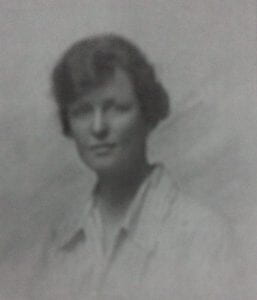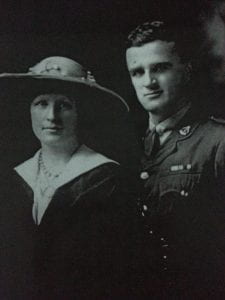This biography was written by Mabel’s granddaughter, Nora Lynch
Mabel Hanron was born in Peshawar (formerly India, now Pakistan) in 1885, the sixth of eleven children born to Michael and Alice Hanron. Her father, having been orphaned in the aftermath of the Irish Potato Famine, had travelled from Eire to India in early adulthood to train as an engineer with the British Army. The changing fortunes of colonial India eventually unsettled the family, prompting their emigration to Nelson in 1888. Mabel spent her school years on the struggling family farm in Stanley Brook where her mother Alice quietly pursued a revolutionary plan to ensure that ‘no daughter of hers was to slave over a hot stove, day in day out, nor was she to soil her hands and grow old before her time’. She was determined that ‘the boys were to work on the farm to provide money for the girls to obtain a good education’ despite the impecunious position of the family and occasional criticism from within the local community. Following her matriculation from Nelson Girl’s College in 1904, Mabel taught primary school classes until the family could finally afford for her to begin the medical training which her mother had planned for her.
Mabel studied first at Victoria University College in 1911, then continued her medical degree at Otago University from 1914. Life in Dunedin was harsh. There was little family money available for food and board for her or her sister Nora, who was studying dentistry, and their health suffered because of this. Mabel graduated MBChB in 1917, the nineteenth medical woman to emerge from Otago University. Her first appointment was as House Surgeon and Physician at Dunedin Hospital, followed by a year as medical officer at Mangonui Hospital in the Far North. Her daughter later recalled stories of weighty responsibility and isolation, including a late night spent refreshing her anatomy knowledge before operating alone to remove a gangrenous upper limb. Reputedly the patient survived!
She married her classmate, Robert Lyall Christie in 1919 and almost immediately moved with him to Samoa where he took up an appointment as Medical Officer at Apia Hospital. Mabel was 35 years old when gave birth to a daughter the following year. She was indeed an ‘elderly primagravida’ and this was to be her only living child; sadly a subsequent son was stillborn.
Mabel resumed her medical career in Samoa, working to improve the health services to mothers and children, alongside the wife of the American Vice Consul Dr Regina Keyes Roberts and local nurses. During 1925, she travelled to 85 villages ‘on foot, horse and canoe for nine months …to explain and help establish the health committees and train the committee executive in basic first aid and sanitation’. An annual report of her work, presented to the New Zealand Department of Health in 1926 (reflecting the annexed status of Western Samoa at that time), makes interesting reading. Contemporary colonial patronage lies juxtaposed with authentic compassion, respect for Samoan women and practical public health wisdom. Her assertion that ‘the baby needs no other food than its mother’s milk, and not only is other food unnecessary but is doing the baby a great deal of harm’ remains relevant almost a century later.
In 1927, Mabel and her family moved to Rarotonga when her husband was appointed Medical Superintendent of the Cook Islands. It is unclear whether she practised medicine during their four year sojourn there. The family returned permanently to live in New Zealand in 1931, as their only daughter approached secondary school age.
Tragically, Mabel’s husband died in a motor vehicle accident in Wellington the following year when she was just 47 years old. It was a trauma from which her daughter believed she never fully recovered. Thrust into the role of breadwinner, she took a position as medical officer at the Waikouaiti Health Camp in 1933, a role commonly undertaken by medical women of that era. She subsequently worked in Auckland on her own account between 1935-6, advertising her services as a Physician and Dietitian and sharing rooms in Civic House Queen St with her dentist sister. Her daughter understood the practice failed because in the midst to a worldwide financial depression, ‘everyone paid the doctor last’. It appears she never worked again. Mabel bought land, moved to west Auckland in her early 50s and lived here until her death in 1955 at the age of 70.
As I reflect on the life of a grandmother who I never knew, I am struck by the tenacity of her family who defied financial constraint and social mores to facilitate education for her and her sisters. As for the woman herself, it is difficult to really know her character but her pioneering child health work in Samoa suggests abundant energy, sharp intellect and a social conscience. It is not difficult to believe the family narrative that the sadness of early widowhood extinguished a light which was never properly reignited.
References:
- N.Hanron The Hanrons. Background to the Hanron Family in Ireland, India and New Zealand. Unpublished family monograph, 1994. p.43
- ibid.
- ibid, p.54.
- P. Thomas, Australian National University. ‘The Samoan Women’s Health Committees: a study of community vulnerability and resilience.’ Presented to the NZ Development Network Conference, Otago University, November 2014. http://devnet.org.nz/sites/default/files/Thomas%20Paper%20for%20Devnet%20Conf%202014%20for%20NZDEVNET%20website.pdf. Accessed online Feb 2018.
- M. Christie, ‘Child Welfare Work in Western Samoa’, in Appendix to the Journals of the House of Representatives. 1926 Session1, pp.38-41.


